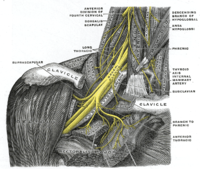
Photo from wikipedia
PURPOSE (1) To determine the prevalence of musculoskeletal complaints (MSCs) in the non-affected bodily structures in individuals with brachial plexus injury (BPI) and (2) to analyse factors associated with MSCs… Click to show full abstract
PURPOSE (1) To determine the prevalence of musculoskeletal complaints (MSCs) in the non-affected bodily structures in individuals with brachial plexus injury (BPI) and (2) to analyse factors associated with MSCs and disability. METHODS Survey among individuals with BPI and a control group. Multivariable logistic and linear regression analyses were used to identify factors associated with MSCs or disability. RESULTS Forty-nine percent of individuals (34/70) with BPI experienced MSC, which was not significantly different from controls (35%, n = 40/113). Complaints were most often located in high back (OR = 3.6) or non-affected limb (OR = 2.2) or neck (OR = 2.1). Greater disability was associated with the presence of MSC in individuals with BPI (OR = 1.1, 95% confidence interval (95% CI) = 1.0; 1.1). Those with no or a low level of education (B = -10.2, 95% CI = -19.6; -1.4), a history of nerve surgery (B = 11.1, 95% CI = -0.2; 20.9), and moderately affected active range of motion (AROM) of the affected limb (B = 20.7, 95% CI = 8.8; 31.0) experienced most disability. Individuals with severely affected AROM showed a wide range of experienced disability. CONCLUSIONS Clinicians should be aware that almost half of individuals with BPI have MSCs in the non-affected bodily structures, which was associated with increased disability.Implications for rehabilitationMusculoskeletal complaints of the non-affected limb, back and neck are common among individuals with brachial plexus injury, and are associated with more disability.Disability was associated with loss of active range of motion (AROM) in the affected limb, although there was a wide variation in experienced disability among individuals with no or a very limited AROM.
Journal Title: Disability and rehabilitation
Year Published: 2022
Link to full text (if available)
Share on Social Media: Sign Up to like & get
recommendations!